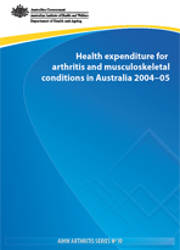Summary
Around 6 million Australians experience long-term pain and disability from arthritis and musculoskeletal conditions. Hospital-admitted patient services and prescription pharmaceuticals are at the forefront in managing these conditions and the associated costs account for more than two-thirds of expenditure for these conditions.
This report focuses on health expenditure on arthritis and musculoskeletal conditions in 2004-05 and also compares it with expenditure in 2000-01. The estimates are derived from the Australian Institute of Health and Welfare (AIHW) Disease expenditure database, supported with information from various other data sources held at the AIHW.
In 2004-05, arthritis and musculoskeletal conditions
- were the fourth largest overall contributor to direct health expenditure in Australia. At $4.0 billion, they accounted for 7.5% of the total spending attributed to the major disease areas
- accounted for more expenditure on care by GPs and medical specialists (out-of-hospital medical services) than any other disease area, including cardiovascular disease.
Of the expenditure on these conditions
- osteoarthritis, rheumatoid arthritis, osteoporosis, chronic back pain and slipped disc accounted for more than half ($2.2 b)
- osteoarthritis alone accounted for nearly one-third, most of it (75%) due to hospital costs, mainly related to knee and hip replacements
- females ($2.2 b) accounted for more than males ($1.7 b), reflecting greater prevalence of the conditions overall, in females (excludes research expenditure)
- hospital inpatient care accounted for just over half (51%) and nearly half of that was due to knee and hip replacements
- prescription pharmaceuticals accounted for almost three-quarters ($215 million) of expenditure for osteoporosis and over half ($92 m) of rheumatoid arthritis expenditure, illustrating the common use of medication to manage them.
Changes over time
- On average, real (inflation-adjusted) health expenditure on arthritis and musculoskeletal conditions increased by 5.2% annually between 2000-01 and 2004-05.
- Overall expenditure on admitted patient services for osteoarthritis increased 82%, in current prices, from $493m in 2000-01 to $898m in 2004-05.
- The amount spent on prescribed pharmaceuticals for managing osteoporosis ($215m) has nearly tripled, in current prices, since 2000-01 ($75.5m).



